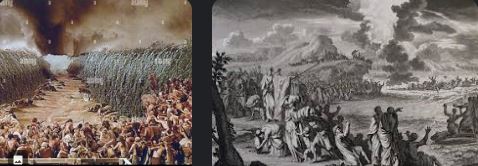Red Sea Spiritual Meaning. What does the red sea crossing represent: Understanding the Spiritual Meaning of the Red Sea Crossing
The Red Sea Crossing represents one of the most iconic narratives found in the Biblical scriptures, filled with profound spiritual significance and symbolism. It is a story woven deeply into the fabric of various religious traditions, often viewed as a testament to faith and divine intervention. Our journey into its depths will explore its historical context and spiritual meanings.
Historical Context of the Red Sea Crossing

Brief Recounting of the Exodus Story
The event commonly known as the Red Sea Crossing is narrated in Exodus, the second book of the Bible. It recounts the liberation of the Israelites, led by Moses, from the oppressive rule of Pharaoh in Egypt. The Israelites were in a dire situation with the Red Sea’s expanse and Pharaoh’s approaching army. In a miraculous turn of events, Moses, guided by God, raised his staff, and the sea parted, allowing the Israelites to cross on dry land. As they crossed, the Egyptian army followed, and the waters returned, engulfing them while the Israelites made their way safely to the other side. This story is a powerful narrative of liberation, divine intervention, and faith in the face of apparent impossibility.
Contents
- Historical Context of the Red Sea Crossing
- Spiritual Significance in Biblical Terms
- The Red Sea in Jewish Tradition
- The Red Sea Crossing in Christian Interpretation
- The Red Sea in Gnostic Interpretations
- Psychological Perspective (Jungian Analysis)
- Practical Lessons from the Red Sea Crossing
- The Red Sea Crossing in Modern Culture
Role of Moses and the Israelites
Moses, an important prophet in the Abrahamic religions, plays a pivotal role in this event. His faith and obedience to God’s commands led the Israelites out of Egyptian bondage. Despite their initial fear and disbelief, the Israelites trusted Moses and God’s promise, embarking on this journey to freedom. Their trust, despite the apparent impossibility of their circumstances, symbolizes the virtue of unwavering faith.
Read More HERE: Red Sea Crossing Evidence!
Egyptian Perspective on the Red Sea Crossing
The Egyptians, led by Pharaoh, represent an opposing force in this narrative. Their relentless pursuit of the Israelites, even after witnessing the Ten Plagues and the parting of the Red Sea, symbolizes obstinate resistance against divine will. Their eventual fate serves as a warning of the consequences of defiance against divine authority.
The historical context of the Red Sea Crossing sets the stage for its manifold spiritual interpretations. By understanding the Exodus narrative, and the roles of Moses, the Israelites, and the Egyptians, we can delve deeper into the spiritual symbolism inherent in this transformative event.
Up next, we’ll explore the spiritual significance of the Red Sea Crossing in biblical terms, offering deeper insights into this profound narrative.
Spiritual Significance in Biblical Terms

The Red Sea as a Symbol of Salvation
The Red Sea Crossing holds immense spiritual significance as a symbol of salvation. This spiritual metaphor illustrates God’s power to deliver and redeem His people from seemingly insurmountable adversities. The parting of the great Red Sea and the safe passage of the Israelites, followed by the engulfing of the Egyptian forces, are potent symbols of divine salvation. In Christian theology, crossing the Red Sea is also seen as a typology of baptism. Just as the Israelites were saved from their pursuers, Christians believe that through baptism, they are protected from sin and death.
Divine Guidance: Pillar of Cloud and Fire
The divine presence during the Exodus was manifested as a pillar of cloud on a sunny day and a pillar of fire by night. It symbolizes God’s direct guidance, protection, and continual presence with His people. Such pillars may not be literal in our lives, but they can be recognized as wisdom, inner strength, spiritual leaders, scriptures, and signs that guide us on our spiritual journey.
| Biblical Symbol | Modern Equivalent |
|---|---|
| Pillar of Cloud | Wisdom, Inner Peace |
| Pillar of Fire | Spiritual Leaders, Scriptures |
Faith and Obedience: Red Sea Crossing as a Test
The event of the Red Sea Crossing was not just a physical journey but an actual spiritual test of faith and obedience for the Israelites. Despite fear and doubt, they trusted in Moses and God’s promise. Their compliance led them to freedom and symbolized the blessings of faith and adherence to divine commandments.
The Red Sea Crossing is a historical event laden with spiritual lessons applicable even today. It invites us to understand faith’s power, obedience’s importance, and the assurance of divine guidance and salvation. As we continue to explore the spiritual meanings behind the Red Sea Crossing, we’ll delve deeper into its broader interpretations in the subsequent sections.
The Red Sea in Jewish Tradition

Importance in Passover
In the Jewish tradition, the Red Sea Crossing holds a significant place, especially during the celebration of Passover. Passover commemorates the historical liberation of the Israelites from Egyptian bondage, and the parting of the Red Sea is one of the pivotal events remembered during this holiday.
The Seder meal, the focal point of the Passover observance, involves retelling the Exodus story. Each meal component has a symbolic meaning related to the Israelites’ journey, including their miraculous escape through the Red Sea. This event is a testament to God’s intervention and liberation, reminding us that freedom can emerge from the most oppressive circumstances.
Symbolism in the Haggadah
 The Haggadah, the Jewish text recited during the Passover Seder, contains detailed accounts of the Israelites’ Exodus from Egypt. The crossing of the Red Sea, described vividly in the Haggadah, is a high point of the narration.
The Haggadah, the Jewish text recited during the Passover Seder, contains detailed accounts of the Israelites’ Exodus from Egypt. The crossing of the Red Sea, described vividly in the Haggadah, is a high point of the narration.
Songs such as “Dayenu” and the reading of “Shirat Hayam” (The Song of the Sea) recite praises and thanks to God for the miracles at the Red Sea. They depict the awe-inspiring power of God, who created a path in the sea for His people and then closed it upon their pursuers.
| Symbol | Meaning in Passover Haggadah |
|---|---|
| The Red Sea | Divine intervention, Miraculous escape |
| Shirat Hayam | Praise for deliverance, recognition of divine power |
Lessons from the Journey through the Wilderness
The narrative of the Israelites’ journey through the wilderness after crossing the Red Sea is also spiritually instructive. This period is often viewed as a trial, testing, and transformation time. They had to rely solely on God’s providence for their daily sustenance, which was supplied as manna and quail.
The wilderness experience thus reinforces the spiritual lesson of trust and reliance on God, lessons that are as applicable even today as they were thousands of years ago. As we explore the Red Sea Crossing further, these enduring truths will continue to surface, underscoring the timeless relevance of this spiritual event.
The Red Sea Crossing in Christian Interpretation

Red Sea Crossing as Baptism
The Red Sea Crossing is frequently seen as an allegory for baptism within Christian interpretations. The Apostle Paul, in his first exciting letter to the Corinthians (1 Corinthians 10:1-2), refers to the event as being “baptized into Moses in the cloud and the sea.” This event symbolizes a spiritual transition or transformation – from slavery to freedom, which parallels the Christian experience of liberation from sin through the sacrament of baptism.
Baptism in Christian theology signifies the believer’s identification with the death, sorrowful burial, and resurrection of Jesus Christ. Just as the Israelites were delivered from physical bondage, the believer is seen to be freed from spiritual bondage.
| Symbol | Meaning in Christian Interpretation |
|---|---|
| The Red Sea | Spiritual transition, liberation from sin |
Yeshua (Jesus) and the Red Sea Symbolism
The parting of the famous Red Sea is also seen to prefigure the ministry of Yeshua (Jesus). As Moses led the Israelites out of physical bondage, Jesus, in the New Testament, is seen as the more outstanding Moses who leads humanity out of spiritual bondage.
Jesus’ miracles, particularly the calming of the storm (Mark 4:35-41), are seen as reminiscent of the Red Sea crossing, where divine power is exercised over nature to provide a path of salvation for God’s people. It emphasizes the Christian belief in Jesus as the ultimate redeemer.
The Journey Towards the Promised Land as a Christian Life Metaphor
Lastly, the journey of the Israelites towards the Promised Land, which began with the crossing of the Red Sea, is often interpreted as a metaphor for the Christian life. The wilderness journey mirrors the Christian’s spiritual journey with its trials, tribulations, and reliance on God’s providence.
Christians are seen as pilgrims journeying toward the heavenly Promised Land. Crossing the Red Sea marks the start of this spiritual journey, signifying a decisive break from the old life and a courageous step into a new life under God’s guidance and care.
The Red Sea in Gnostic Interpretations

The Red Sea as a Baptismal Water of Rebirth and Transcendence
In the realm of Gnostic interpretations, the Red Sea crossing assumes a profound metaphorical significance. It’s seen as a symbol of spiritual rebirth and transcendence. The water is considered purifying and regenerative, washing away the old and heralding the new, similar to baptism. The sea becomes a liminal space, a place of transition between the raw material and the spiritual, the known and the unknown.
| Gnostic Symbol | Interpretation |
|---|---|
| The Red Sea | Rebirth, Transition, Transcendence |
Augustine and Honorius of Autun’s Views
St. Augustine (354-430 CE), an early Christian theologian and clever philosopher whose writings were very influential in developing Christian and Gnostic thought, drew a parallel between the Red Sea crossing and the soul’s journey in search of salvation. Similarly, Honorius of Autun (1080-1154 CE), a Christian scholar, viewed the event as symbolic of the soul’s journey from earthly to heavenly life.
| Thinker | Viewpoint |
|---|---|
| Augustine | Red Sea as the soul’s journey toward salvation |
| Honorius of Autun | Symbol of the transition from earthly to heavenly life |
Individuation Process and the Journey into the Unconscious
Expanding further, the Red Sea Crossing also aligns with the individuation process, a term used by Carl Jung to describe how a person becomes a psychological “individual” or, in his words, a “self.” It is a journey of self-discovery, a venture into the depths of one’s psyche.
The Israelites’ Exodus from Egypt can be viewed as leaving behind the unconscious mind’s habitual patterns. Crossing the Red Sea signifies a plunge into the unconscious to confront and overcome fears and obstacles, emerging on the other side as an integrated, whole individual.
| Jungian Concept | Interpretation |
|---|---|
| Individuation | Crossing the Red Sea as a journey of self-discovery and personal growth |
Psychological Perspective (Jungian Analysis)

Crossing the Red Sea as a Metaphor for Personal Growth
In the lexicon of Carl Jung’s psychological theories, crossing the Red Sea is a potent metaphor for personal growth and development. It’s a process that involves leaving behind the familiar, embracing uncertainty, and venturing into uncharted territory – much like how the Israelites ventured forth from the bondage of Egypt. The sea symbolizes the tumultuous emotional and psychological struggles one must navigate in seeking self-realization and wholeness.
| Jungian Concept | Interpretation |
| Crossing the Red Sea | Metaphor for personal growth and development |
The Red Sea and the Collective Unconscious
The Red Sea Crossing also holds significance in the context of the collective unconscious, a term coined by Jung. The collective unconscious refers to dark structures of the unconscious mind shared among ordinary beings of the same species. It’s thought to contain archetypes, universal symbols, and themes in the myths and legends of cultures worldwide. The Red Sea story, shared across generations and cultures, forms part of this collective unconscious, encapsulating universal human experiences of struggle, liberation, and transformation.
| Jungian Concept | Interpretation |
| Collective Unconscious | Red Sea story as a part of universal human experiences of struggle, liberation, and transformation |
Confronting One’s Shadow During the Crossing
Crossing the Red Sea can also be seen as a metaphor for confronting one’s shadow, another key concept in Jungian psychology. The shadow represents the unconscious aspects of the personality, the parts of ourselves that we do not recognize or wish to acknowledge. In the Red Sea crossing narrative, the Israelites had to confront and overcome their fears and doubts—symbolic of their shadow—to make their journey successful.
| Jungian Concept | Interpretation |
| Shadow | Crossing the Red Sea as a metaphor for confronting one’s unconscious aspects |
Practical Lessons from the Red Sea Crossing

Overcoming Life’s Challenges: The Red Sea Obstacles
The account of the Red Sea crossing serves as a poignant reminder of our capacity to overcome life’s challenges. Just as the Israelites faced an insurmountable obstacle in the form of the Red Sea, we, too, encountered numerous obstacles. These could range from personal dilemmas, professional setbacks, or societal pressures. Yet, like the miraculous parting of the Red Sea, these challenges can often lead to unexpected paths and unprecedented opportunities for growth and transformation.
| Practical Lesson | Interpretation |
| Overcoming Life’s Challenges | Red Sea Crossing as a metaphor for overcoming personal, professional or societal obstacles |
Trusting Divine Timing: The Longer Path
 The journey of the Israelites from slavery in Egypt to the Promised Land was neither direct nor immediate. Similarly, the path to our goals and aspirations might sometimes be complicated in our lives. We might have to take detours, face delays, and even tread on the ‘longer path’. However, as the Israelites ultimately reached their destination, so can we get ours by maintaining faith, demonstrating patience, and trusting the process.
The journey of the Israelites from slavery in Egypt to the Promised Land was neither direct nor immediate. Similarly, the path to our goals and aspirations might sometimes be complicated in our lives. We might have to take detours, face delays, and even tread on the ‘longer path’. However, as the Israelites ultimately reached their destination, so can we get ours by maintaining faith, demonstrating patience, and trusting the process.
| Practical Lesson | Interpretation |
| Trusting Divine Timing | The Israelites’ journey as a lesson in patience and faith in the process |
Personal Growth through Trials and Tribulations
The Israelites’ journey was fraught with trials and tribulations, yet these experiences shaped their identity as a community and fostered their spiritual growth. Similarly, our journeys are peppered with hardships and obstacles. However, it is through these dire challenges that we learn, grow, and evolve. The Red Sea crossing thus symbolizes the personal growth that comes through trials and tribulations.
| Practical Lesson | Interpretation |
| Personal Growth | Red Sea Crossing as a symbol of personal growth through trials and tribulations |
The Red Sea Crossing in Modern Culture

The Red Sea in Art and Literature
The Red Sea crossing has been a prominent subject in art and literature, often depicted in paintings and literary works as a triumphant moment of liberation. For instance, the dramatic event of parting the sea has been brought to life in classic novels such as “The Red Tent” by Anita Diamant or visual arts such as “The Crossing of the Red Sea” by Nicolas Poussin.
Reflections in Popular Culture
Popular culture, too, has widely incorporated the Red Sea crossing. This story is retold in numerous films and songs, most notably in the iconic movie “The Ten Commandments”, where the parting of the Red Sea is a pivotal moment. The narrative continues to inspire musicians, filmmakers, and writers, resonating with themes of liberation and resilience.
Red Sea as a Symbol in Social and Political Discourse
The Red Sea crossing has also found its place in social and political discourse, often employed as a symbol of overcoming impossible odds. It has been invoked in speeches by civil rights activists, political leaders, and public figures to signify the power of resilience, faith, and collective action.
Conclusion
The Red Sea Crossing is an enduring narrative that inspires and instructs. The spiritual meanings attached to this tale—of faith, liberation, transformation, and rebirth—resonate deeply with human experiences. Its ongoing relevance underscores the universality of these themes and their profound significance in our individual and collective lives.
References
- “The Red Tent” by Anita Diamant. [Amazon Link]
- “Jung and the Story of Our Time”. A book by Laurens van der Post. [Amazon Link]

Marta Savova is a journalist, health, technolgy and science writer. With over 20 years of experience in the field, she has published numerous research papers and articles and has a passion for sharing his knowledge with others. He is a regular contributor to several media.

While it’s true that there is no direct historical evidence to support the parting of the Red Sea, some historians and archaeologists believe that the biblical account may be based on actual events. For example, there is evidence of many Semitic people living in Egypt during the 13th century BCE, which may correspond to the time when the Israelites were enslaved there.
The location of the parting of the Red Sea is a subject of debate, but some scholars believe that it may have occurred at a place called the “Straits of Tiran,” which is a narrow waterway that connects the Gulf of Aqaba to the Red Sea. There is evidence that this area may have been a shallow crossing point in ancient times.
While some scientists have proposed natural explanations for the parting of the Red Sea, such as strong winds or underwater earthquakes, these theories remain speculative and unproven. Maybe it was a miraculous intervention by God, which natural causes cannot explain.
The parting of the Red Sea is a significant event in Jewish and Christian traditions. For example, in Judaism, the story of the parting of the Red Sea is commemorated during the holiday of Passover, while in Christianity, the event is seen as a foreshadowing of Christ’s resurrection and a symbol of salvation.
The story of the parting of the Red Sea offers many important lessons for us today, such as the importance of trusting in God, following his lead, and having faith in difficult situations. However, it’s also important to recognize that the story may have different meanings and interpretations for different people, depending on their cultural and religious backgrounds. Therefore, it’s essential to approach the story with an open mind and a willingness to learn from different perspectives.
A comprehensive analysis. It’s worth mentioning another interpretation I’ve come across – The Red Sea crossing as a symbol of moving from chaos into order, which fits nicely within the Jungian framework.
Impressive overview! For those interested in the art aspect, you might also want to check out “Moses Parting the Red Sea” by Frederic Arthur Bridgman.